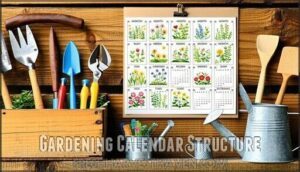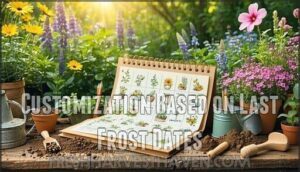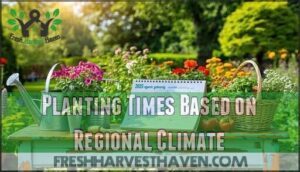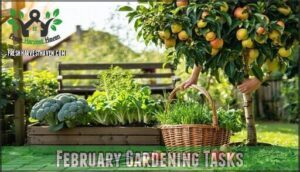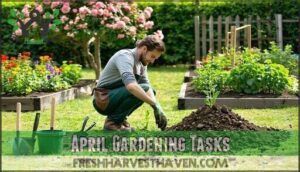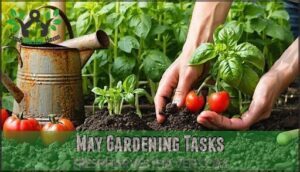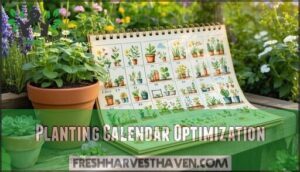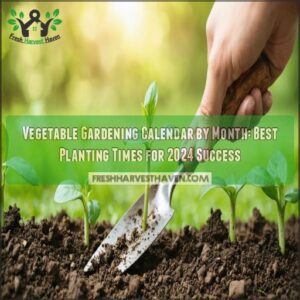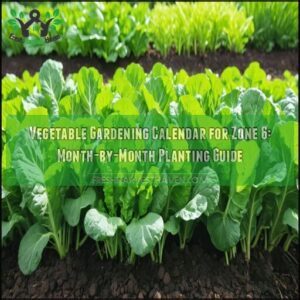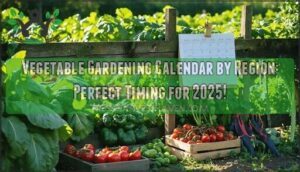This site is supported by our readers. We may earn a commission, at no cost to you, if you purchase through links.
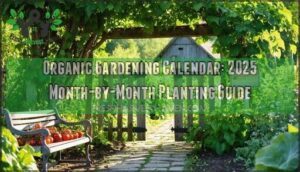 Your organic gardening calendar becomes your roadmap to freedom from synthetic chemicals and store-bought produce.
Your organic gardening calendar becomes your roadmap to freedom from synthetic chemicals and store-bought produce.
You’ll master nature’s rhythms by timing seed starts, transplants, and harvests with seasonal cues.
In January, you’re planning and ordering heirloom seeds while your soil rests.
By March, cool-season crops like lettuce and peas hit the ground.
May brings warm-season favorites like tomatoes and peppers after frost danger passes.
Your calendar tracks succession plantings every two weeks for continuous harvests, soil amendment schedules, and pest management using beneficial insects.
Think of it as your garden’s GPS – it keeps you on track toward bountiful, chemical-free harvests year-round.
Table Of Contents
- Key Takeaways
- Organic Gardening Basics
- Gardening Calendar Structure
- Regional Gardening Considerations
- Gardening Tasks and Schedules
- Planting Calendar Optimization
- Frequently Asked Questions (FAQs)
- . Why Should You Start Seeds indoors?
- . Which Seeds Should You Start indoors?
- . When Should You Start Seeds indoors?
- . When Should You Transplant seedlings?
- What is the gardening 3 year rule?
- What vegetables to plant in what month?
- Is organic gardening worth it?
- What is the best free gardening app for 2024?
- . Why Should You Start Seeds indoors?
- . Which Seeds Should You Start indoors?
- Conclusion
Key Takeaways
- You’ll master timing by using your organic gardening calendar to schedule seed starting, transplants, and harvests based on frost dates and soil temperatures rather than guessing when to plant.
- You’ll maintain soil health through strategic crop rotation every three years and regular soil testing, preventing nutrient depletion and disease buildup while maximizing your garden’s productivity.
- You’ll achieve continuous harvests by planning succession plantings every two weeks and tracking growth stages, ensuring fresh produce throughout the growing season instead of overwhelming gluts.
- You’ll save money and avoid pesticides by growing your own organic produce using natural pest management techniques and beneficial insects, reducing grocery bills while improving your family’s health.
Organic Gardening Basics
You’ll discover that successful organic gardening relies on understanding your soil’s nutrient balance, timing your plantings with frost dates, and maintaining consistent moisture levels throughout the growing season.
Master your soil, time your seeds, and watch nature reward your patience with abundant harvests.
This thorough approach combines crop rotation principles with natural pest management techniques, ensuring your vegetables and flowers thrive without synthetic chemicals while maximizing your harvest potential.
Monthly Garden Projects
The right monthly gardening projects turn your backyard into a productive paradise. Planning ahead means you’ll spend less time scrambling and more time enjoying your harvest.
Garden Planning starts with mapping your crops and designing a layout that works. Soil Prep involves testing pH levels and adding compost or organic matter. Weed Control becomes manageable when you mulch heavily or tackle weeds before they establish deep roots. Pruning Tips vary by season—trim fruit trees in late winter, deadhead flowers in summer. Your Garden Layout should consider sunlight patterns and water access.
An organic gardening calendar keeps these tasks organized:
- Test soil pH and nutrient levels monthly
- Schedule crop rotation to prevent disease buildup
- Plan succession plantings for continuous harvests
- Track pest populations and beneficial insects
- Maintain compost piles with proper green-to-brown ratios
Gardening by month with structured monthly task lists means you’ll never miss critical timing windows.
Customized Notes Section
Your organic garden journal becomes your secret weapon when you harness the customized notes section in your organic gardening calendar.
Transform basic note taking into strategic crop tracking by recording soil temperatures, pest patterns, and harvest yields.
This personalized gardening calendar lets you fine-tune your gardening plans with personal reminders about what worked and what didn’t.
Garden notes capture everything from unexpected frost dates to companion planting successes.
Smart gardening journaling turns casual observations into powerful garden tracking data that improves next season’s results.
Category What to Track
Seeding Schedules for Flowers and Vegetables
Transform your garden into a productive paradise by mastering seeding schedules that sync with nature’s rhythm.
Cool-season vegetables like lettuce need a 4-6 week head start before your last frost date, while warm-season crops wait for soil temperatures above 60°F.
Flower planting requires soil preparation that goes 2 inches deeper than root depth for ideal establishment.
- Seed Starting: Time your indoor sowing to match frost dates and soil temperature requirements
- Crop Rotation: Rotate vegetable families annually to maintain soil health and break pest cycles
- Garden Planning: Stagger planting schedules for continuous harvests throughout the growing season
Gardening Calendar Structure
Your organic gardening calendar works like a well-organized toolbox, with weekly tasks, seeding dates, fertilizing schedules, and lawn reminders all mapped out to keep your garden thriving year-round.
This structured approach takes the guesswork out of timing, so you’ll know exactly when to start seeds indoors, transplant seedlings, and maintain your soil’s health throughout each growing season, using a well-organized toolbox and following a structured approach.
Weekly Gardening Tasks
Consistently following weekly gardening tasks keeps your organic garden thriving year-round. Your organic gardening calendar should include essential maintenance that prevents small problems from becoming major headaches.
Soil Checks come first—test moisture levels by inserting your finger two inches deep. If it’s dry, your plants need water. Water Management means deep, infrequent watering rather than daily sprinkles.
Pest Control requires weekly inspections under leaves and around stems. Catch aphids early by wiping them off with mild soapy water. Clean your tools thoroughly after handling diseased plants—this prevents spreading issues throughout your garden.
Tool Maintenance includes cleaning and oiling equipment after each use. Sharp, clean tools make every job easier and protect plant health.
Garden Planning happens weekly too. Update your planting schedules, note what’s working, and plan next week’s projects. These consistent weekly gardening tasks form the foundation of successful monthly gardening routines. Effective gardening also involves using the right Gardening Tools to make tasks more efficient.
Seeding and Planting Dates
Perfect timing matters more than perfect weather when you’re mastering seed starting. Your organic gardening calendar becomes your roadmap to success through strategic planting schedules.
Understanding your spring garden planning is essential for a thriving garden.
- Calculate planting dates from your last frost date
- Prepare soil with compost before seeding schedules begin
- Plan crop rotation for healthier harvests
- Match planting times with soil temperature
- Track your vegetable planting calendar religiously
Fertilizing Schedules
With your seeding dates locked in, it’s time to map out when your plants will need their nutritional boost. Think of fertilizing schedules as your garden’s meal plan—timing matters more than you’d think.
Soil testing reveals what your plants are actually craving, not what you assume they need. Most gardeners skip this step and wonder why their tomatoes look grumpy despite weekly feedings.
Your organic gardening calendar should include these fertilizer timing checkpoints:
- Early spring: Apply compost tea when soil temperatures hit 50°F to wake up beneficial microbes
- Pre-planting: Work slow-release organic fertilizers into beds 2-3 weeks before transplanting
- Mid-season: Side-dress heavy feeders like corn and squash with balanced organic blends
- Late summer: Switch to low-nitrogen fertilizers to help plants prepare for dormancy
- Fall cleanup: Add composted manure to restore nutrient balance for next season
Smart fertilizing schedules prevent both nutrient deficiencies and the dreaded over-fertilization that creates lush leaves but zero fruit.
Lawn Maintenance Reminders
Your gardening calendar includes lawn maintenance reminders that keep your yard thriving year-round.
Mowing tips help you cut at proper heights while lawn aeration loosens compacted soil.
Fertilizer application timing guarantees deep root growth, and natural weed control methods protect your grass.
Pest management strategies and organic gardening tips create healthy lawns without harsh chemicals—gardening by month made simple.
Regional Gardening Considerations
Your garden’s success depends on understanding your specific climate zone and local growing conditions.
You’ll need to adjust planting dates based on your last frost date, soil temperature patterns, and microclimates that can vary even within your neighborhood.
Northeastern United States Climate
Why does the Northeastern United States challenge even experienced gardeners?
The region’s humid continental climate spans USDA Plant Hardiness zone 5 through zone 7, creating diverse microclimates within short distances. Weather patterns shift unpredictably, making frost dates essential for timing.
Soil temperature varies dramatically—from 32°F winters to 85°F summers. An organic gardening calendar helps you navigate these climate zones effectively.
Track local weather patterns and microclimates to maximize your growing season success. Understanding cold climate strategies is essential for thriving in this region.
Customization Based on Last Frost Dates
Without knowing your last frost date, you’re basically gardening blindfolded. Your organic gardening calendar becomes laser-focused when you customize it using frost date planning and climate zones data.
Here’s how to nail your planting schedule:
- Calculate seed starting dates by working backward from frost dates
- Adjust gardening schedules for your specific gardening zones
- Use USDA hardiness maps for precise harvest timing
- Account for microclimates in your yard
- Plan succession plantings around frost-free periods
Future Regional Calendars
Current organic gardening calendar coverage focuses on northeastern regions, but expansion plans promise Climate Zones across America.
Future regional calendars will deliver precise Regional Planning through advanced Gardening Apps and Calendar Customization features.
Zone Mapping technology guarantees your organic gardening calendar adapts to local conditions perfectly.
These upcoming tools revolutionize how you approach seasonal planting:
- Climate-specific planting schedules suited to your exact hardiness zone
- Automated frost date calculations that adjust recommendations annually
- Regional pest and disease alerts synchronized with local growing conditions
Planting Times Based on Regional Climate
When you master your climate zone, you’ll achieve gardening success.
Understanding Frost Dates and Soil Temperature transforms amateur attempts into abundant harvests.
Your Regional Planning strategy should account for local Microclimates—that sunny corner or shaded valley can shift your planting calendar by weeks.
Climate Zones aren’t just numbers; they’re your roadmap to seasonal planting victory.
- Track gardening by zip code data for hyper-local precision
- Monitor soil warmth before direct seeding tender crops
- Observe regional gardening patterns from experienced neighbors
Your climate zone dictates timing, not trends.
Gardening Tasks and Schedules
You’ll need a clear schedule to track soil testing, seed starting, and pruning tasks that change with each season’s unique demands.
These monthly gardening schedules help you time everything from winter soil preparation to spring transplanting, ensuring your organic garden thrives through proper planning and consistent care.
January Gardening Tasks
January kicks off your organic gardening calendar with foundational tasks that’ll pay dividends all season long. Start with soil testing—think of it as your garden’s annual physical exam. Check pH levels and nutrient content while the ground rests. For accurate results, consider using a reliable soil testing kit to assess your garden’s needs.
Begin seed starting indoors for cool-season crops like lettuce and spinach. Your planting schedule depends on getting these babies going early.
Winter pruning is prime time now—trim dormant fruit trees and berry bushes to boost spring growth. Tool maintenance matters too; sharpen those pruners and oil wooden handles.
Don’t skip frost protection for tender perennials. These january gardening tasks set your monthly gardening tasks up for success.
February Gardening Tasks
February gardening tasks mark the beginning of your garden’s awakening from winter slumber. While frost still nips at your heels, there’s plenty you can accomplish to set yourself up for success.
To promote a healthy garden ecosystem, consider implementing bird care tips to attract beneficial species.
- Pruning Tips: Trim fruit trees and shrubs before buds break dormancy, improving air circulation and removing dead wood.
- Soil Prep: Test soil pH and incorporate organic compost to create nutrient-rich growing beds.
- Seed Starting: Begin indoor sowing of cool-season crops like broccoli, kale, and onions using sterile potting mix.
- Tool Maintenance: Sharpen pruners and clean garden tools while you’ve got time before spring’s rush begins.
March Gardening Tasks
March marks the awakening of your garden, so roll up your sleeves! Focus on soil preparation by testing and enriching it with organic compost.
Tackle weed control early with mulching or manual removal. Start seeds indoors for crops like peppers or tomatoes while planning your garden layout.
Outdoors, plant hardy vegetables like radishes or carrots once the soil’s workable. Keep pruning tools handy for shaping shrubs or clearing dead growth.
| Task | Tools Needed | Tips for Success |
|---|---|---|
| Soil Preparation | Compost, Tiller | Test soil pH before amending. |
| Weed Control | Hoe, Mulch | Remove weeds after rainfall. |
| Seed Starting | Trays, Grow Lights | Use seedling heat mats. |
| Garden Layout | Graph Paper | Rotate crops for soil health. |
| Pruning Tips | Pruners, Gloves | Prune on dry, sunny mornings. |
April Gardening Tasks
April’s here, and it’s time to get your hands dirty!
Your organic gardening calendar highlights key tasks to jumpstart the season:
- Soil Preparation: Boost your soil’s nutrients with well-aged compost, ensuring seedlings thrive.
- Weed Control: Stop weeds early—pulling them now saves headaches later and keeps your planting schedule on track.
- Garden Layout: Map out your beds, focusing on crop rotation and spacing to maximize vegetable cultivation and reduce pests.
April gardening tasks set the groundwork for vibrant growth and bountiful harvests!
May Gardening Tasks
May’s warmth signals it’s time to supercharge your organic gardening calendar.
Start with soil preparation—loosen and enrich it for warm-weather crops like tomatoes and peppers.
Stick to your planting schedule and rotate crops to maintain healthy soil.
Early weed control saves headaches later, so pull them while they’re manageable.
Check plants daily for pests—catching them early prevents damage.
Add stakes or cages for plant support as growth surges.
Water deeply, encouraging strong roots.
Stay on top of these May gardening tasks for a bountiful vegetable cultivation season!
Planting Calendar Optimization
You’ll get better harvests by timing your planting to match soil temperatures, frost dates, and your region’s growing season.
With careful planning, you can stagger crops, avoid bolting, and keep your garden productive all year long.
Optimal Planting Times
Timing makes or breaks your garden. The organic gardening calendar helps you sync with nature for lush harvests.
Success hinges on these four factors:
- Lunar Cycles: Plant leafy greens during waxing moons and root crops as it wanes. Nature’s clock works wonders.
- Frost Dates: Check your zone’s last frost to nail seed starting without risking tender seedlings.
- Soil Temperature: Seeds won’t sprout in cold soil. Use a thermometer—patience pays off.
- Crop Rotation: Avoid planting the same crops repeatedly. It keeps pests guessing and soil thriving.
Understanding a summer vegetable planting calendar is vital for ideal growth.
Master these, and you’ll harvest like a pro!
Planting Schedules for Success
A thriving garden starts with smart planning.
Your organic gardening calendar simplifies seed starting, crop rotation, and soil preparation, ensuring planting schedules for success.
Begin with cool-season crops, then shift to warm-season varieties.
Rotate crops annually to prevent soil depletion and pests.
Succession planting keeps your harvest flowing.
Here’s a quick guide:
| Task | Timing | Benefit |
|---|---|---|
| Seed Starting | Early Spring | Early growth boost |
| Soil Preparation | Pre-Planting | Nutrient-rich soil |
| Crop Rotation | Annually | Prevents soil fatigue |
| Succession Planting | Bi-Weekly | Continuous harvests |
Plan well, and your garden will reward you!
Crop Growth Rates and Planting Frequency
Mastering crop growth rates is like reading your garden’s rhythm—it’s the secret to organic gardening success.
Aligning planting frequency with growth stages helps achieve healthier plants and abundant harvests.
Think of it as a dance where timing is everything.
Understanding plant growth patterns is vital for maximum yields.
Here’s your step-by-step guide:
- Seed Starting: Follow planting schedules based on frost-free days for a strong start.
- Growth Stages: Track days to maturity for precise harvest timing.
- Plant Spacing: Avoid overcrowding to let plants breathe and thrive.
- Crop Rotation: Keep soil fertile and pests guessing.
- Succession Planting: Sow every two weeks for continuous yields.
Get your hands dirty—your garden will thank you!
Resistance to Bolting for Extended Harvest
Bolting prevention starts with smart seed selection. Choose varieties like ‘Slow Bolt’ cilantro and ‘Nevada’ lettuce for resistance to bolting.
Your soil management practices matter too—consistent moisture and mulching create stable growing conditions that prevent stress-induced flowering.
| Crop | Bolt-Resistant Variety | Planting Strategy |
|---|---|---|
| Lettuce | Nevada Batavian | Succession plant every 2 weeks |
| Cilantro | Slow Bolt | Plant in partial shade during summer |
| Beets | Robin | Harvest at baby size for sweetness |
| Broccoli | Heat-tolerant cultivars | Use row covers in hot weather |
| Kale | Winterbor | Plant late summer for fall harvest |
Extended harvest depends on proper crop variety choices and planting frequency adjustments for your organic gardening success.
Harvesting and Crop Considerations
Beyond planting schedules, successful harvesting and crop considerations determine your garden’s productivity. Smart harvest timing transforms average yields into abundant harvests, while proper soil quality maintenance supports consistent growth throughout seasons.
Here’s your yield optimization checklist:
- Monitor ripeness indicators daily during peak harvest periods
- Implement strategic crop rotation to prevent soil depletion
- Practice integrated pest management using beneficial companion plants
- Schedule succession plantings every 2-3 weeks for continuous production
- Test soil pH quarterly to maintain ideal growing conditions
Your organic gardening calendar should reflect these crop yield management principles for maximum success.
Frequently Asked Questions (FAQs)
. Why Should You Start Seeds indoors?
Starting seeds indoors gives you control over timing, protects seedlings from unpredictable weather, and extends your growing season. You’ll get stronger transplants, save money, and access varieties unavailable at nurseries.
. Which Seeds Should You Start indoors?
You’ll want to start warm-season crops like tomatoes, peppers, eggplant, and basil indoors since they need controlled temperatures.
Cool-season vegetables like lettuce, kale, and broccoli also benefit from indoor starting for earlier harvests.
. When Should You Start Seeds indoors?
Like telegraph operators timing their messages, you’ll start seeds indoors 6-12 weeks before your last frost date.
Check seed packets for specific timing—tomatoes need 6-8 weeks, while peppers require 8-10 weeks for ideal transplant readiness.
. When Should You Transplant seedlings?
Transplant your seedlings when they’ve developed their second set of true leaves and nighttime temperatures consistently stay above 50°F. You’ll typically wait 2-4 weeks after germination, depending on the variety.
What is the gardening 3 year rule?
Picture yourself as a crop rotation detective, solving the mystery of soil depletion.
You’ll rotate plant families every three years to prevent nutrient exhaustion and disease buildup.
This proven method keeps your garden thriving naturally.
What vegetables to plant in what month?
Spring calls for cool-season crops like lettuce, peas, and spinach in March-April.
Summer demands warm-weather champions like tomatoes, peppers, and beans in May-June.
Fall welcomes hardy vegetables like kale, carrots, and radishes again.
Is organic gardening worth it?
Sarah saved $800 annually growing her own tomatoes versus buying organic ones at $6 per pound.
You’ll slash grocery bills, eliminate pesticide exposure, and boost soil health while enjoying fresher, more nutritious produce year-round, which also helps to slash grocery bills.
What is the best free gardening app for 2024?
You’ll find PlantNet and iNaturalist dominate 2024’s free gardening apps.
PlantNet identifies plants instantly using photos, while iNaturalist connects you with expert botanists.
Both offer offline functionality and extensive plant databases for serious gardeners.
. Why Should You Start Seeds indoors?
You’ll gain a 6-8 week head start on your growing season by starting seeds indoors.
This extends your harvest window, gives you better variety selection, and saves money compared to buying transplants.
. Which Seeds Should You Start indoors?
You’ll want to start warm-season crops like tomatoes, peppers, eggplant, and basil indoors since they need longer growing seasons. Cool-season vegetables like lettuce and broccoli can handle direct sowing outdoors.
Conclusion
Gone are the days of guessing when to plant or wondering why your harvest failed.
Your organic gardening calendar transforms chaotic seasonal cycles into predictable success patterns. You’ll confidently schedule plantings, track succession crops, and coordinate soil amendments with nature’s timing.
This systematic approach eliminates costly mistakes while maximizing yields.
Remember, gardening isn’t just about growing food—it’s about cultivating patience, observation skills, and connection to natural rhythms that sustain both plants and gardeners, following a systematic approach.
- http://mailto:organicgardeningcalendar
- https://www.ncdc.noaa.gov/cgi-bin/climatenormals/climatenormals.pl?directive=prod_select2&prodtype=CLIM2001&subrnum%2520to%2520Freeze/Frost%2520Data%2520from%2520the%2520U.S.%2520Climate%2520Normals
- https://sowtrueseed.com/blogs/monthly-garden-schedule-by-zone/febuary-garden-chores
- https://www.epicgardening.com/february-gardening-tasks
- https://www.teraganix.com/blogs/organic-gardening-tips/winter-gardening-calendar-your-month-by-month-guide-for-organic-garden-care

